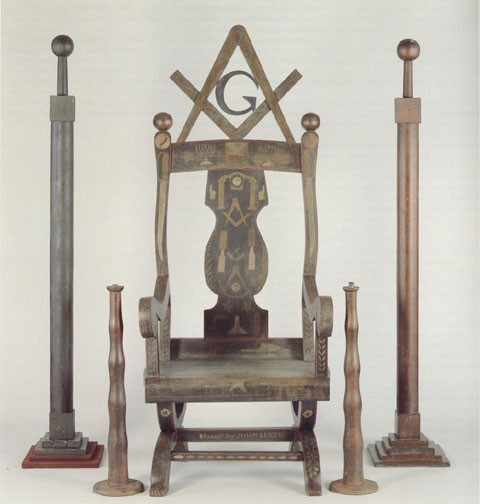
John Luker, Masonic Master’s chair, pillars, and candle stands, Vinton County, Ohio, 1870. (Courtesy, Museum of Our National Heritage; photo, David Bohl.)
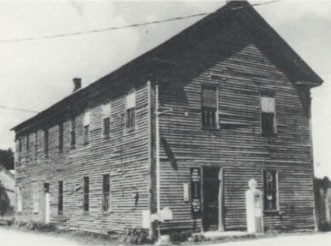
Swan Lodge No. 358, Vinton County, Ohio. This photo probably was taken during the mid-1960s. (Courtesy, Museum of Our National Heritage.)
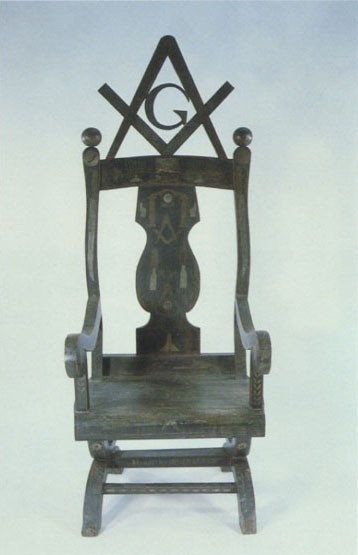
Pretreatment view of the Masonic Master’s chair illustrated in fig. 1. (Photo, Susan Buck.)
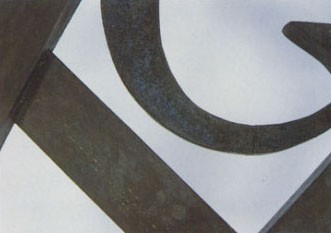
Pretreatment detail of the G, compass, and square of the Masonic Master’s chair illustrated in fig. 1. The surface of the square and dividers was corroded, and the G was encrusted with grime. (Photo, Susan Buck.)

Cross-section of the G of the Masonic Master’s chair photographed in visible light at 125x: (1) white preparatory layer; (2) blue glaze layer; (3) thick pewter powder layer; (4) large smalt particle. (Photo, Susan Buck.)
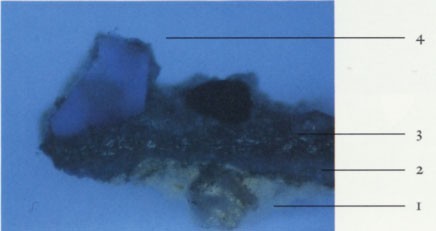
Cross-section of the G of the Masonic Master’s chair photographed in ultraviolet light at 125x: (1) white preparatory layer; (2) blue glaze layer; (3) thick pewter powder layer; (4) large smalt particle. The fluorescence indicates that the blue glaze and metallic powders have a plant resin binding medium. (Photo, Susan Buck).
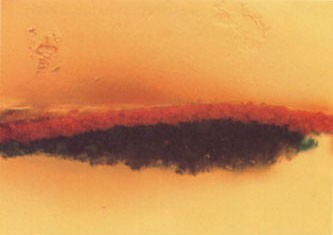
Cross-section of a red stripe on the Masonic Master’s chair photographed in visible light at 500x. (Photo, Susan Buck.)
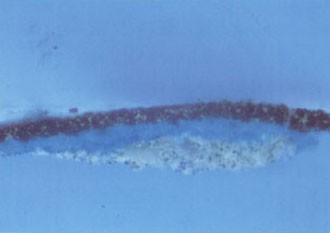
Cross-section of a red stripe on the Masonic Master’s chair photographed in ultraviolet light at 500x. The flourescence indicates that the preparatory layer, blue glaze, and red stripe have a plant resin binding medium and that there is an early plant resin varnish coating on the red stripe. (Photo, Susan Buck.)

Red lead pigment particles with characteristic bright birefringence and isotropic Prussian blue particles photographed with transmitted light under crossed polars at 500x. (Photo, Susan Buck.)

Cross-section of a protected surface under the seat of the Masonic Master’s chair photographed in ultraviolet light at 500x.
A thick layer of cracked, weathered plant resin varnish is visible above the blue glaze layer. (Photo, Susan Buck.)
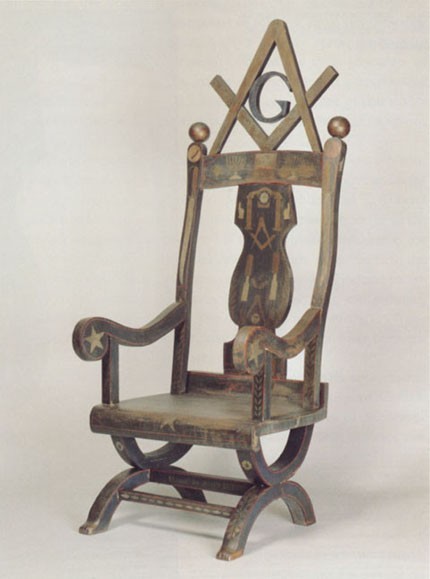
Post-treatment view of the Masonic Master’s chair. The painted surfaces under the seat are closest to the original colors. (Photo, David Bohl.)
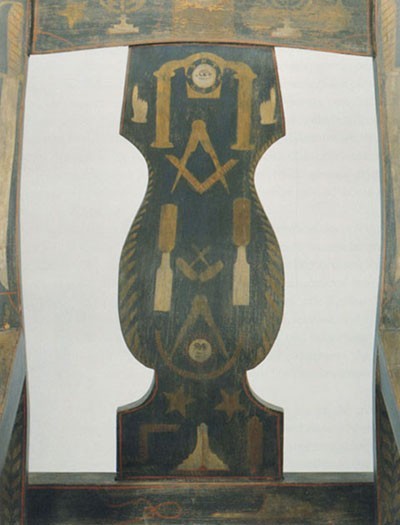
Post-treatment detail of the splat and crest rail of the Masonic Master’s chair. (Photo, David Bohl.)
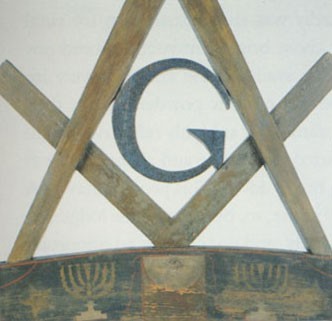
Post-treatment detail of the crest rail, G, compass, and square. Although cleaning helped reveal the red paint and blue glaze, the metallic powder layers remained darkened and corroded. (Photo, David Bohl.)
Of all the conservation fields, furniture conservation has benefited the most from the alternative cleaning systems and ultraviolet light cross-section analysis first developed for the treatment of easel paintings.[1] This technology enables us to determine the original appearance of furniture, to interpret more accurately the intentions of the tradesman and patron, and to develop appropriate conservation treatments.
In the fall of 1991, the Society for the Preservation of New England Antiquities Conservation Center began treatment of an unusual suite of Masonic furniture owned by the Museum of Our National Heritage in Lexington, Massachusetts. The suite consists of a very large armchair, two tall pillars, and two candle stands (fig. 1). The armchair bears the signature “Manufact’d by John Luker” painted in gold-colored metallic powders on the front face of the medial stretcher and the name “Houston,” also in gold, painted on the left leg. Luker evidently made and decorated the chair for J. H. M. Houston who served as Worshipful Master of Swan Lodge No. 358 in Swan, Vinton County, Ohio, from 1867 to 1873 (fig. 2).[2]
Although awkwardly constructed, with a combination of pegged mortise-and-tenon and dowel joints, the overall structure of the chair in 1991 was sound (fig. 3). As the Master’s chair, it had served an important symbolic function, but it also had suffered from regular use and eventual abuse. In addition to considerable paint loss, there were major repairs to the G on the crest; and cracks in the legs, arm-seat joints, and seat were all filled with a brittle white substance. Holes on the underside of each foot indicated that the chair was fitted with casters at some point.
Upon initial examination, the background color of the chair appeared to be black, and the edges of virtually all the structural elements had red pinstripes that were somewhat obscured and irregular. The large G above the crest rail was highlighted with a pebbly blue paint, and the Masonic square and compasses were a mottled dark greenish brown (fig. 4). Although many motifs were illegible, a wide variety of painted Masonic symbols were visible on the splat, legs, stiles, and crest rail. However, these too were quite dark because of dirt and degraded varnish.
Paint loss, darkening, and irregularity on unprotected areas, such as the backs of the stiles and splat and the tops of the globes, indicated that the chair was exposed to excessive light, heat, and moisture.[3] The celestial and terrestrial globe finials and the tops of the arms and seat were especially worn and weathered. In addition, the base of the splat, the front of the splat shoe, and the legs had thick accumulations of an opaque, waxy material, and the feet, arms, and stiles had unidentifiable brittle white accretions. Overall the surface of the chair was very uneven and unsightly. The confusing, unstable painted surfaces required careful analysis to characterize the paint and metallic powder layers and to identify the accumulated obscuring materials before experimenting with solvents or water-based cleaning systems.
I removed eighteen samples (100 to 300 microns in size) from painted and metallic powder design areas with a “harpoon,” a sharp scalpel originally designed for eye surgery. By taking the samples from the edges of cracks and areas of loss, I avoided intruding into intact painted surfaces. I encased the samples in small half-inch cubes of polyester resin, cured them for twenty-four hours, ground and polished each at right angles to expose the cross-sections, and analyzed them with a fluorescence microscope at 125x , 250x , and 500x magnifications. A fiber-optic light source allowed me to compare the appearance of the various layers in visible light and in ultraviolet light. In visible light, shellac, plant resin varnishes, and glaze layers are very difficult to distinguish—they all look uniformly translucent brown or tan. In ultraviolet light they fluoresce (or glow) in characteristic ways: shellac fluoresces bright orange; plant resin varnishes (such as copal, mastic, dammar, and sandarac) fluoresce bright white; and plant resin-bound glaze layers appear brilliantly colored depending on the pigments contained in the glaze. In contrast, modern synthetic varnishes tend not to fluoresce and will often appear as very dull blue or lavender layers. To determine the organic materials in each layer I applied a series of fluorescent biological stains that help to identify oils, carbohydrates (starches, sugars, and gums), and proteins (hide glues, egg, or casein) in the binding mediums.[4]
The cross-sections revealed that the background color on the chair was not black but an intense blue glaze consisting of blue pigment particles suspended in a plant resin binder. That glaze had been applied on top of a white priming layer, although in several samples there was an intermediary gray paint layer that may have been an underdrawing. The cross-sections from the G had three layers on top of the blue glaze: a thick layer of silver-colored metallic powder, a layer of large glass-like blue particles, and another layer of blue glaze (figs. 5, 6). This combination originally produced a bright, highly reflective surface. The pinstripes were composed of intense red pigment particles in a plant resin binder (figs. 7, 8), the same medium used to suspend the silver- and gold-colored metallic powders of the Masonic designs. The outer finish surface was an irregular layer of degraded plant resin varnish, above which lay thick accumulations of wax and oily grime.
Application of the biological stains revealed the presence of oil in the binding mediums of all layers and the absence of proteins or carbohydrates. The similar composition of the binding mediums—all having oil-bound plant resin components—severely limited the treatment options for the chair. To remove the degraded varnish layer (to reveal the more intact surfaces below) I had to design a cleaning system that would solubilize only the outer plant resin varnish layer. Alternatively, I could achieve a more legible, aesthetically pleasing surface by saving the remnants of the early varnish coating and removing only the grime and wax layers.
Before proceeding with cleaning I also needed to identify the pigments and metallic powders. I began by scraping particles from protected areas of red pinstripes and blue glazes and from the pebbly surface of the G. Polarized light microscopy (PLM) techniques, microchemical testing procedures, and comparisons to known pigment samples revealed that the blue glaze pigment was Prussian blue, a high tint strength transparent colorant first synthesized in 1704 (fig. 9). It remains relatively stable when exposed to light and air, but if combined in oil and/or resin it appears greenish over time, and if exposed to alkalis it turns brown. When newly applied, the blue glaze was a deep, glossy, rich blue color; 120 years later it was a green-black. The chunky blue particles above the metallic powder layer of the G were smalt, coarse ground glass colored with cobalt. Smalt, a very stable pigment, is generally not affected by light, heat, or acids. The red pinstripe sample contained red lead and vermilion. Red lead, an ancient pigment noted for its brilliance and hiding power, is unstable and darkens when exposed to strong light and high humidity. Vermilion, also an ancient pigment that is intensely red with good hiding power, darkens when exposed to sunlight, especially if used in tempera or watercolor mediums. The combination of these pigments produced a brilliant red-orange color (see fig. 9).[5]
The components of the different metallic powder layers required identification by other analytical methods. A scanning electron microscope (SEM) revealed that the gold-colored powder was composed of brass (80 percent copper, 20 percent zinc). Unlike gold leaf or gold powder, brass powder corrodes and darkens if not protected by a varnish layer. The silver-colored powder was tin with a smaller proportion of lead and trace amounts of zinc—the traditional composition of pewter. Although pure tin powders are quite stable and not prone to tarnishing (unlike silver leaf and powder), the lead and zinc components guaranteed that this “pewter powder” corroded and darkened significantly. SEM analysis also confirmed earlier identifications of Prussian blue, red lead, and vermilion and determined that the primer contained white lead, zinc white, and calcite. The combination of white pigments created a very opaque, bright white ground coating. Application of intense blue glaze over this bright white ground would have created an effect of depth and translucency.[6]
The results of the analysis indicated that this chair would never reveal its true character unless the degraded varnish layer, thick accumulations of wax, and deposits of grime were removed, yet the cross-section samples and materials analysis indicated that cleaning these accumulations from the painted and metallic powder surfaces would be problematic (fig. 10). Polar and aromatic solvents (such as ethanol, benzyl alcohol, acetone, and xylene) would indiscriminately dissolve the varnish coating and underlying glaze layers, and any surfactant cleaning system in water (to remove the thick grime layer) would encourage further corrosion if the cleaner came in contact with the metallic powders.
The only solvent that appeared not to solubilize any of the glaze or powder layers was Stoddard Solvent, essentially a refined version of mineral spirits. Stoddard Solvent, however, left a white haze, suggesting that a substantial amount of wax remained on the surface and possibly in the paint and glaze layers below. Extensive tests produced only one cleaning system that was a moderately effective grime remover—saliva.[7]
After removing the wax with cotton swabs and Stoddard Solvent, I mixed a trial batch of artificial saliva to simulate the viscosity and cleaning effectiveness of actual saliva. To speed the cleaning I raised the pH slightly with dilute sodium hydroxide and, to reduce the possibility of further metallic powder corrosion (because saliva contains water), added a water-soluble corrosion inhibitor to the solution.[8] The result was a controllable, effective cleaning solution to remove the grime layer on all the different design areas.
This procedure left intact the areas of remaining original plant resin varnish and, where the chair had not suffered abrasion or water damage (such as the lower portion of the splat and the sides of the legs), a smooth, somewhat glossy surface was recovered. Fortunately, I was able to save the early varnish layer where it still survived and reveal a pleasing, intensely colored surface. But the only area that remained comparatively intact and provides some sense of the brilliance of the original palette is the side of the right leg where the wide overhang of the seat protected the paints and glazes from exposure to sun, rain, and abrasion (fig. 11).
Using dental tools, I removed the small white accretions stuck to the legs and stiles of the chair, and I used a soft brush to gently push away the loose dirt and dust trapped around the large smalt particles; this surface was too fragile for any further cleaning. A spraycoat of a synthetic matte varnish that is reversible, protective, and appropriate in appearance proved to be the final step.[9]
Before cleaning, many of the painted and metallic powder symbols on the chair were partially or almost completely obscured. For Masons, these images represent the physical world, and they play an important role in conveying the practices and teachings of the Craft. It proved to be particularly significant that the chair was blue rather than black: “The color blue has always been associated with what is deemed beneficial: chastity, fidelity, immortality and prudence. The blue canopy of heaven is the covering of the Universal Lodge of Freemasonry.” Some Masonic lodges are referred to as “Blue Lodges,” and in many lodges the ceiling in the central room is painted blue, sometimes with lights or stars to simulate a night sky. Red also had significance for Masons. It is the color of the Royal Arch symbol and denotes a fervor for knowledge, advanced degrees, and enlightenment.[10]
As the surface cleaning progressed, the images became more visible and their intent more obvious (fig. 12). For example, the slipper-shaped form on the splat shoe represented the Rite of Discalceation, where the apprentice removes one shoe before entering the lodge as a sign of humility before God and trust in his fellow lodge members. The date “1870” executed in gold-colored metallic powders on the top of the right side of the splat shoe indicated the year the chair was made. The curled form next to the slipper represented the cabletow, a symbol of brotherly love. A candidate for membership was traditionally initiated by being wrapped with the cabletow (or rope) and led blindfolded, wearing only one slipper, around the lodge room, ending up in the northeast corner where the cornerstone of a building is laid. There his blindfold was removed, and he saw “the light.” This rite is symbolic of the light, or knowledge, of Masonry being revealed to the new member.[11]
Other important symbols on the chair include: silver stars that represent God and the five points of Masonic Fellowship; swords symbolizing the confidentiality that guards the purity of Masonic ritual and the jewels of office; acacia leaves symbolizing faith; a Masonic apron symbolizing the Rite of Investiture or Purification—one of the three great rites of Masonry—during which the new mason is presented with a lambskin or white leather apron. The level is a symbol of equality; the plumb rule, a symbol of uprightness; and the trowel, the symbol of brotherly love (see fig. 12).[12]
Of particular interest are a number of relatively recent Masonic symbols. The hourglass, the scythe, and the G centered between the square and compasses are all American forms (fig. 13). Masonic author Allan E. Roberts claims that around 1873 “some unknown inventor added a letter ‘G’ in the center of the square and compasses.” If this information is correct, the Master’s chair, dated 1870, may mark one of the first times the G in the center of the square and compasses was used. Representing God and geometry, the G is often depicted in Masonic drawings as shining, with radiating lines extending from the design.[13] The method of painting the G on the chair, using silver metallic powder, blue glazes, and large smalt particles, produced a shining, sparkling surface.
The pillars and candle stands figured less prominently in the conservation treatment because they were in stable condition and lacked painted Masonic symbols (see fig. 1). One pillar was painted blue, very similar to the color of the armchair, and the other was red-brown and had a thick, resinous varnish coating. The only major repair to the blue pillar was the replacement of the base with a felt-covered piece of wood, probably done years ago by a member of the lodge. Both candle stands had a dark brown stain and a wax coating. It is unclear whether the stained surface is original or the result of a later refinishing; however, candle wax attached to the sides and tops of both stands indicates that the stain dates to the period of their use. I used a mild nonionic surfactant cleaning system to remove accumulated grime on all four objects. Then I waxed and buffed the dark red pillar and brown candle stands and sprayed the blue pillar with two coats of Soluvar Matte Varnish to match the surface coating on the chair.[14]
Most likely the two pillars represent Jachin and Boaz—the two columns at the entrance of Solomon’s Temple, which are the symbolic foundations of many of the great truths of Freemasonry. The right pillar, Boaz, symbolizes strength, or power. The left pillar, Jachin, symbolizes the establishment, or choice and control. In general, the column form also symbolizes the five steps—Tuscan, Doric, Ionic, Corinthian and Composite—necessary to reach the second level, or Fellowcraft Degree.[15]
Although only two candle stands from the suite are known, lodges traditionally have three burning tapers symbolizing the sun, the moon, and the Worshipful Master. Light plays an important literal role in Masonic ceremonies, and the “three lights” are usually positioned in the middle of the center room of the lodge.[16] Swan Lodge No. 358 was dilapidated and abandoned when the suite was discovered in situ in 1966, so it is conceivable that a third taper had been removed or destroyed.
With its curule-style legs, fanciful painting, and massive crest ornament, the Masonic Master’s chair undoubtedly was an unusual form for rural Ohio in the 1870s (see fig. 11). Luker chose bright, intensely colored raw pigments that would have been readily available and comparatively inexpensive. His choice of brass and pewter metallic powders meant that, although the metallic powder designs started out as highly reflective, bright gold and silver-colored areas, they started to corrode and change color as soon as the protective varnish coating broke down. This process may have begun while the Master’s chair was still in use, so, by the time the lodge was abandoned, the surface was dark, unsightly, and not considered important enough to save.
Given the adverse conditions affecting the suite, it is miraculous that the pieces survived with most of the original material intact.[17] Recent technological developments now allow conservators to understand better the original intent of the maker, to reconstruct more effectively what an object might have looked like in use, and to conserve more appropriately the surfaces and structures that survive.
ACKNOWLEDGMENTS
Research funding for this project was provided in part by the Samuel H. Kress Foundation. The author thanks John Hamilton and Maureen Harper for their contributions to the treatment process and to this article.
Richard C. Wolbers and Gregory Landrey, “Use of Direct Reactive Fluorescent Dyes for the Characterization of Binding Media in Cross Sectional Examinations,” 15th Annual AIC Meeting, Vancouver, British Columbia, 1987, pp. 168–202.
Ibid., pp. 30, 56.
Ibid., pp. 12, 56. Roberts did not cite any references to support his claim, but he noted that “in other languages God does not start with the letter ‘G,’ nor does Geometry,” implying that the use of G in non-English-speaking countries would not convey the same message and thus would not be used in this form.
Waldwin Percival, Masonry and Its Symbols in the Light of Thinking and Destiny (New York: The WORD Publishing Co., 1952), p. 54. Roberts, Craft and Its Symbols, p. 56.
“More Light” is referred to as the true Masonic Prayer. For more on the symbolism of light, see Roberts, Craft and Its Symbols, p. 32; and Percival, Masonry and Its Symbols, p. 54.
Mr. J. Denny Kitchen discovered the suite in a ruined Masonic temple in rural Ohio over twenty-five years ago. The objects were wet from roof leaks and covered with bird droppings. To slow the drying process and save the painted surfaces, he coated them with a thick layer of beeswax-based furniture polish. Because the chair was too tall to fit into his house, he removed the casters and stored them away in a box (the author thanks Mr. Kitchen for this information).
